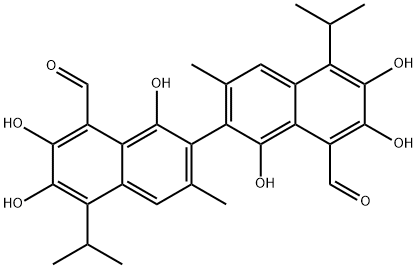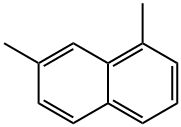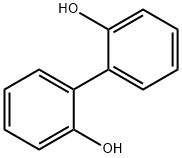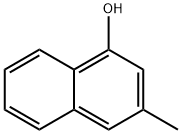A7580158
(±)-Gossypolfromcottonseeds , 10mMinDMSO , 303-45-7
Synonym(s):
(±)-2,2′-bis(8-Formyl-1,6,7-trihydroxy-5-isopropyl-3-methylnaphthalene)
CAS NO.:303-45-7
Empirical Formula: C30H30O8
Molecular Weight: 518.55
MDL number: MFCD00017352
EINECS: 636-899-7
| Pack Size | Price | Stock | Quantity |
| 1ml | RMB241.60 | In Stock |
|
| others | Enquire |
Update time: 2022-07-08
PRODUCT Properties
| Melting point: | 181-183 C |
| Boiling point: | 522.63°C (rough estimate) |
| Density | 1.1912 (rough estimate) |
| refractive index | 1.4900 (estimate) |
| storage temp. | 2-8°C |
| solubility | ≥25.95 mg/mL in DMSO; insoluble in H2O; ≥2.1 mg/mL in EtOH |
| form | Off-white to yellow solid. |
| pka | 7.15±0.50(Predicted) |
| color | Light yellow to yellow |
| Water Solubility | Soluble in 100%ethanol (25 mg/ml), DMF (25 mg/ml), acetone, DMSO (25 mM), methanol (2 mg/ml), ether, chloroform, sodium carbonate, and dilute aqueous solutions of ammonia . Insoluble in water. Gossypol is a male antifertility agent with antispermatogenic activity and has been shown to contain antitumor, anitviral, and antioxidant properties. |
| InChI | InChI=1S/C30H30O8/c1-11(2)19-15-7-13(5)21(27(35)23(15)17(9-31)25(33)29(19)37)22-14(6)8-16-20(12(3)4)30(38)26(34)18(10-32)24(16)28(22)36/h7-12,33-38H,1-6H3 |
| InChIKey | QBKSWRVVCFFDOT-UHFFFAOYSA-N |
| SMILES | C1(O)=C2C(C(C(C)C)=C(O)C(O)=C2C=O)=CC(C)=C1C1=C(C)C=C2C(=C1O)C(C=O)=C(O)C(O)=C2C(C)C |
| LogP | 5.419 (est) |
| CAS DataBase Reference | 303-45-7 |
| EPA Substance Registry System | [2,2'-Binaphthalene]-8,8'-dicarboxaldehyde, 1,1',6,6',7,7'-hexahydroxy-3,3'-dimethyl-5,5'-bis(1-methylethyl)- (303-45-7) |
Description and Uses
Gossypol is mainly present in the roots, stems, leaves, and seeds of the plant cotton, and the highest content is found in cotton seeds. Its chemical structure was first determined by Adams in 1938 and was used to be studied in antitumor research.
antispermatogenic, antineoplastic, antiHIV
Safety
| Symbol(GHS) |   GHS07,GHS08 |
| Signal word | Danger |
| Hazard statements | H302-H360F |
| Precautionary statements | P201-P202-P264-P270-P301+P312-P308+P313 |
| Hazard Codes | Xn,Xi |
| Risk Statements | 22-40-36/37/38 |
| Safety Statements | 22-36-36/37/39-27-26 |
| WGK Germany | 3 |
| RTECS | DU3100000 |
| HS Code | 29124990 |
| Hazardous Substances Data | 303-45-7(Hazardous Substances Data) |
| Toxicity | A secondary plant product produced by some varieties of cotton and found in cottonseed meal and cottonseed oil from those varieties. Affects the male reproductive system and has potential use as a male contraceptive agent. May be irritating to the GI tract. In animal studies large doses caused lung edema and paralysis. |






